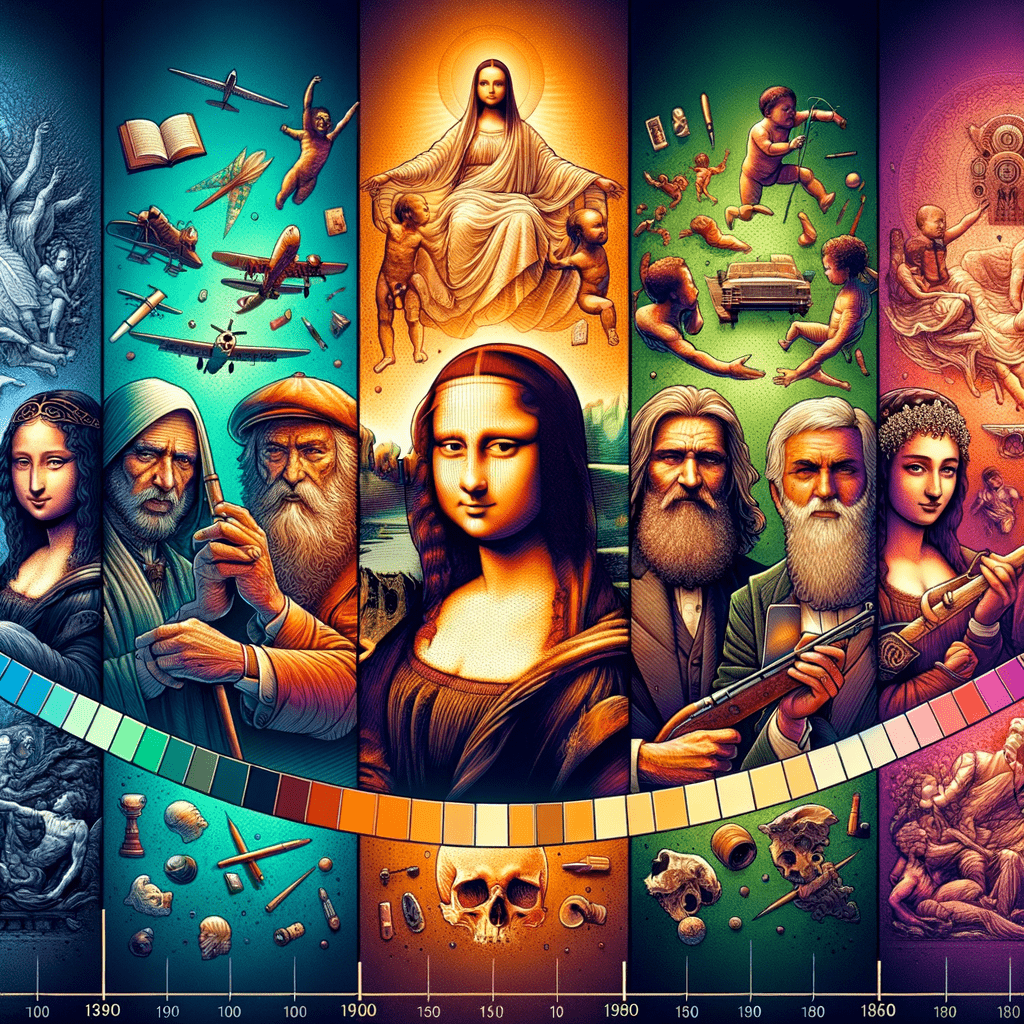An overview of the most influential artistic movements in the history of art, from the Renaissance to Post-modernism, and their lasting impact on global culture.
The history of art is filled with movements that have revolutionized the way we perceive the world and culture. These movements have not only influenced artists and their works but have also had a profound impact on society and global culture. In this article, we will explore five artistic movements that changed the world, analyzing their historical context, key characteristics, and lasting impact.
1. Renaissance
The Renaissance, which took place between the 14th and 17th centuries, is one of the most celebrated periods in art history. This movement originated in Italy and spread across Europe, marking a rebirth of classical culture and a renewed interest in science, philosophy, and art.
Key Features
- Rediscovery of Classical Antiquity
- Centrality of Man and the Individual
- Linear perspective and realistic proportions
- Development of Oil Painting Techniques
Iconic Artists and Works
Some of the most famous artists of the Renaissance include Leonardo da Vinci, Michelangelo, Raphael, and Donatello. Works such as Leonardo’s “Mona Lisa,” Michelangelo’s “David”, and Raphael’s “School of Athens” are emblematic examples of this period.
Lasting Impact
The Renaissance had a lasting impact on global culture, influencing not only art but also science, philosophy, and literature. The rediscovery of classical texts and the emphasis on reason and observation laid the groundwork for the Enlightenment and the Scientific Revolution.
2. Baroque
The Baroque, which developed between the late 16th and early 18th centuries, is known for its dramatic, emotional, and ornamental style. This movement originated in Italy and quickly spread throughout Europe, influencing architecture, painting, sculpture, and music.
Key Features
- Dramatic use of light and shadow (chiaroscuro)
- Dynamic and Lively Compositions
- Rich and detailed decorations
- Emotionality and Theatricality
Iconic Artists and Works
Among the most renowned artists of the Baroque period are Caravaggio, Gian Lorenzo Bernini, and Peter Paul Rubens. Works like “The Calling of Saint Matthew” by Caravaggio, “The Ecstasy of Saint Teresa” by Bernini, and “The Three Graces” by Rubens are representative examples of this movement.
Lasting Impact
The Baroque had a significant impact on art and architecture, influencing the development of Rococo and Neoclassicism. Its emphasis on emotion and theatricality also had a lasting influence on music and theater.
3. Impressionism
The Impressionism movement, which originated in France at the end of the 19th century, is known for its innovative approach to painting, characterized by quick brushstrokes and vibrant colors. This movement represented a break from academic conventions and paved the way for new forms of artistic expression.
Key Characteristics
- Quick, visible brushstrokes
- Innovative Use of Color and Light
- Depiction of everyday life scenes
- Emphasis on visual impression rather than details
Artists and Iconic Works
Among the most famous Impressionist artists are Claude Monet, Edgar Degas, and Pierre-Auguste Renoir. Works like Monet’s “Impression, Sunrise,” Degas’s “The Dance Class,” and Renoir’s “Dance at Le Moulin de la Galette” are emblematic examples of this movement.
Lasting Impact
The Impressionism has had a lasting impact on modern art, influencing subsequent movements such as Post-Impressionism and Fauvism. Its emphasis on visual experience and innovative use of color opened new possibilities for 20th-century artists.
4. Cubism
Cubism, developed in the early 20th century by Pablo Picasso and Georges Braque, is known for its fragmented and geometric representation of reality. This movement marked a radical break with previous artistic conventions and paved the way for new forms of visual expression.
Key Characteristics
- Fragmented and Geometric Representation of Reality
- Use of abstract and angular forms
- Multiple and Simultaneous Perspectives
- Focus on structure and composition
Iconic Artists and Works
Among the most renowned artists of Cubism, we find Pablo Picasso, Georges Braque, and Juan Gris. Works such as Picasso’s “Les Demoiselles d’Avignon,” Braque’s “Violin and Candlestick,” and Gris’s “Portrait of Picasso” are representative examples of this movement.
Lasting Impact
The Cubism movement had a significant impact on modern art, influencing subsequent movements such as Futurism, Constructivism, and Surrealism. Its emphasis on structure and composition opened new possibilities for 20th-century artists.
5. Postmodernism
Postmodernism, which emerged in the second half of the 20th century, is known for its critique of traditional artistic and cultural conventions. This movement represented a break with Modernism and paved the way for new forms of artistic and cultural expression.
Key Characteristics
- Criticism of Traditional Artistic and Cultural Conventions
- Use of Popular and Mass Culture Elements
- Emphasis on plurality and diversity
- Eclectic and Interdisciplinary Approach
Iconic Artists and Works
Among the most notable artists of Post-modernism are Andy Warhol, Jean-Michel Basquiat, and Cindy Sherman. Works such as “Marilyn Diptych” by Warhol, “Untitled” by Basquiat and “Untitled Film Stills” by Sherman are representative examples of this movement.
Lasting Impact
The Post-modernism has had a significant impact on contemporary culture, influencing not only art but also architecture, literature, cinema, and music. Its emphasis on plurality and diversity has opened new possibilities for artists and creatives of the 21st century.
Conclusion
In conclusion, artistic movements such as the Renaissance, Baroque, Impressionism, Cubism, and Post-modernism have had a lasting impact on global culture. These movements not only revolutionized the way we perceive art, but also profoundly influenced society and culture. Their legacy continues to live on in the works of contemporary artists and in our daily lives.
For further insights into artistic movements, visit the Treccani Encyclopedia website.




